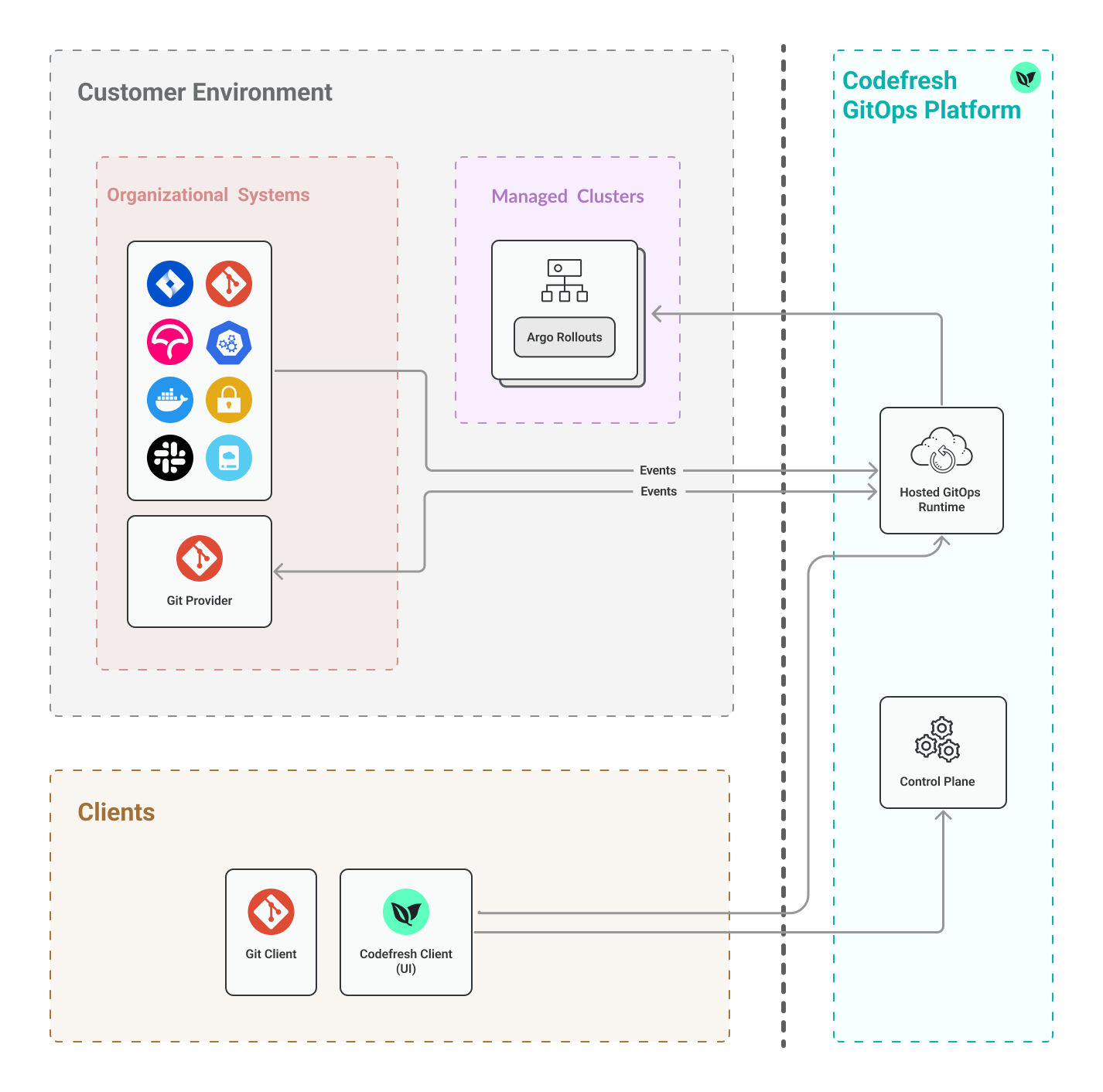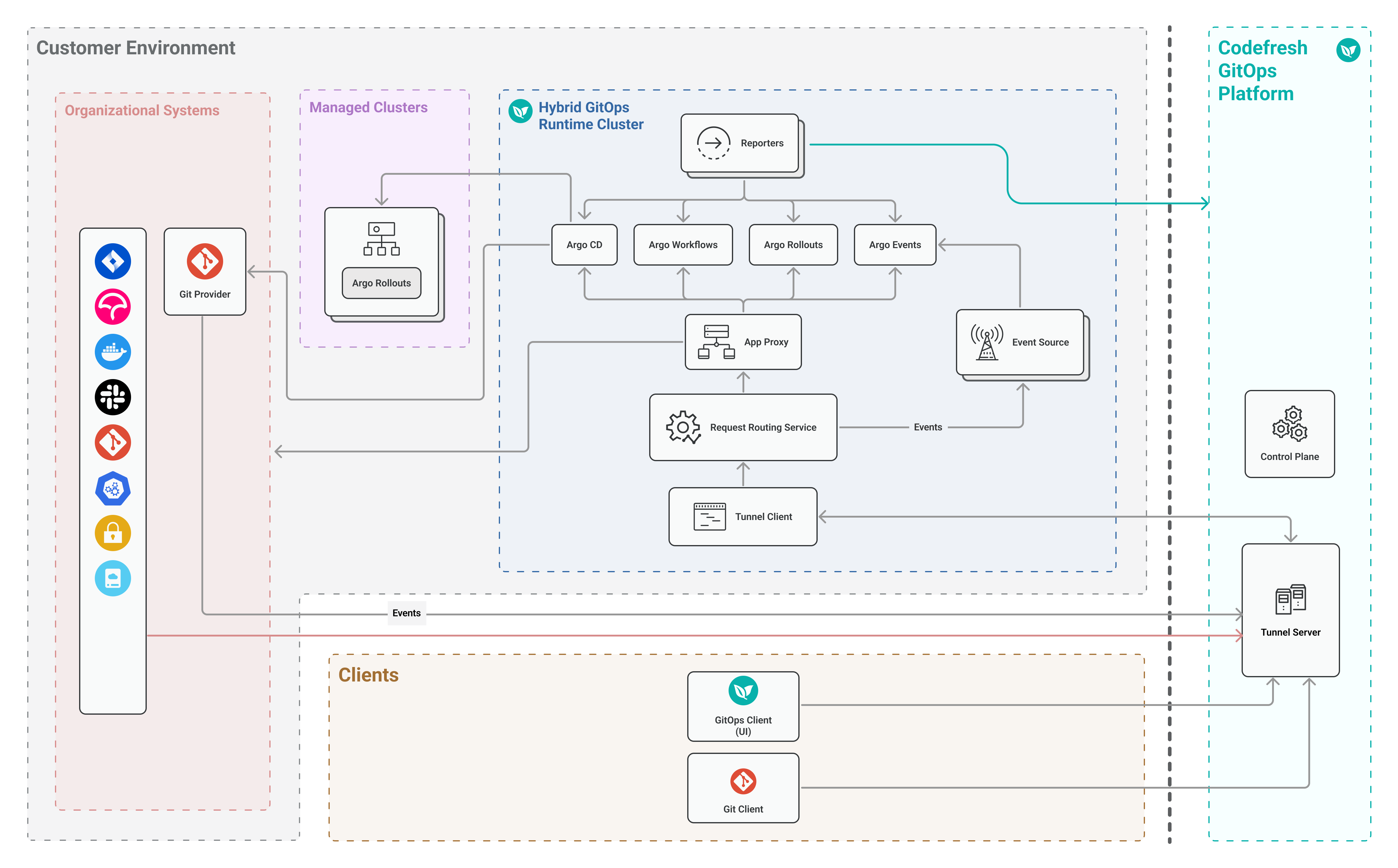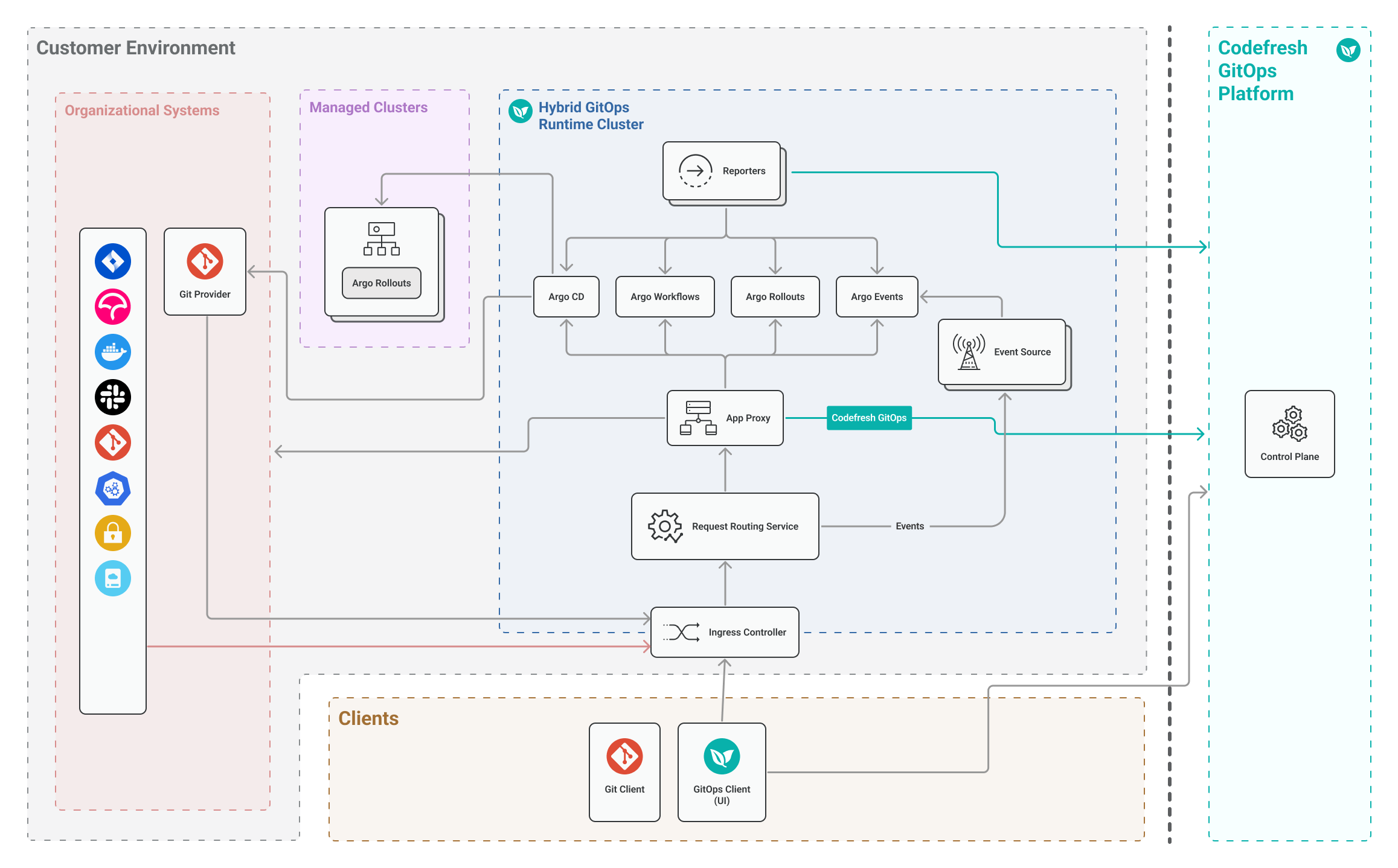GitOps Runtime architecture
View components of GitOps Runtimes
See detailed views of GitOps Runtime architecture for the different installation modes, and descriptions of the GitOps Runtime components.
- Hosted GitOps Runtime architecture
- Hybrid GitOps Runtime architecture: The Hybrid GitOps Runtime can be tunnel- or ingress-based:
- GitOps Runtime components
Hosted GitOps Runtime architecture
In the hosted environment, the Codefresh Runtime is installed on a K8s cluster managed by Codefresh.
Tunnel-based Hybrid GitOps Runtime architecture
Tunnel-based Hybrid GitOps Runtimes use tunneling instead of ingress controllers to control communication between the GitOps Runtime in the customer cluster and the Codefresh GitOps Platform. Tunnel-based runtimes are optimal when the cluster with the GitOps Runtime is not exposed to the internet.
NOTE
Tunnel-based access mode is not supported for GitOps on-premises installations.
Note: Tunnel-based architecture is not supported for on-prem instances.
Ingress-based Hybrid GitOps Runtime architecture
Ingress-based Runtimes use ingress controllers to control communication between the GitOps Runtime in the customer cluster and the Codefresh GitOps Platform. Ingress-based Runtimes are optimal when the cluster with the GitOps Runtime is exposed to the internet.
Application Proxy
The GitOps Application Proxy (App-Proxy) functions as the Codefresh agent, and is deployed as a service in the GitOps Runtime.
For tunnel-based Hybrid GitOps Runtimes, the Tunnel Client forwards the incoming traffic from the Tunnel Server using the Request Routing Service to the GitOps App-Proxy. For Hybrid GitOps Runtimes with ingress, the App-Proxy is the single point-of-contact between the GitOps Runtime, and the GitOps Clients, the GitOps Platform, and any organizational systems in the customer environment.
The GitOps App-Proxy:
- Accepts and serves requests from GitOps Clients either via the UI or CLI
- Retrieves a list of Git repositories for visualization in the Client interfaces
- Retrieves permissions from the GitOps Control Plane to authenticate and authorize users for the required operations.
- Implements commits for GitOps-controlled entities, such as Delivery Pipelines and other CI resources
- Implements state-change operations for non-GitOps controlled entities, such as terminating Argo Workflows
Argo Project
The Argo Project includes:
- Argo CD for declarative continuous deployment
- Argo Rollouts for progressive delivery
- Argo Workflows as the workflow engine
- Argo Events for event-driven workflow automation framework
NOTE
Codefresh users rely on our platform to deliver software reliably, and predictably without interruption.
To maintain that high standard, we add several weeks of testing and bug fixes to new versions of Argo before making them available within Codefresh.
Typically, new versions of Argo CD are available in the Codefresh Runtime within 30 days of their official release.
Request Routing Service
The Request Routing Service is installed on the same cluster as the GitOps Runtime in the customer environment.
It receives requests from the the Tunnel Client (tunnel-based) or the ingress controller (ingress-based), and forwards the request URLs to the Application Proxy, and webhooks directly to the Event Sources.
IMPORTANT
The Request Routing Service is available from Runtime version 0.0.543 and higher.
Older Runtime versions are not affected as there is complete backward compatibility, and the ingress controller continues to route incoming requests.
Tunnel Server
Applies only to tunnel-based Hybrid GitOps Runtimes.
The Codefresh Tunnel Server is installed in the Codefresh platform. It communicates with the enterprise cluster located behind a NAT or firewall.
The Tunnel Server:
- Forwards traffic from Codefresh Clients to the client (customer) cluster.
- Manages the lifecycle of the Tunnel Client.
- Authenticates requests from the Tunnel Client to open tunneling connections.
Tunnel Client
Applies only to tunnel-based Hybrid GitOps Runtimes.
Installed on the same cluster as the Hybrid GitOps Runtime, the Tunnel Client establishes the tunneling connection to the Tunnel Server via the WebSocket Secure (WSS) protocol.
A single Hybrid GitOps Runtime can have a single Tunnel Client.
The Tunnel Client:
- Initiates the connection with the Tunnel Server.
- Forwards the incoming traffic from the Tunnel Server through the Request Routing Service to App-Proxy, and other services.
Customer environment
The customer environment that communicates with the GitOps Runtime and Codefresh generally includes:
- Ingress controller for ingress-based Hybrid GitOps Runtimes
The ingress controller is configured on the same Kubernetes cluster as the GitOps Runtime, and implements the ingress traffic rules for the GitOps Runtime. See Ingress controller requirements. - Managed clusters
Managed clusters are external clusters registered to provisioned Hosted or Hybrid GitOps Runtimes for application deployment.
Hosted GitOps requires you to connect at least one external K8s cluster as part of setting up the Hosted GitOps environment.
Hybrid GitOps allow you to add external clusters after provisioning the Runtimes.
See Managing external clusters in GitOps Runtimes. - Organizational systems
Organizational Systems include the customer’s tracking, monitoring, notification, container registries, Git providers, and other systems. They can be entirely on-premises or in the public cloud.
Either the ingress controller (ingress hybrid environments), or the Tunnel Client (tunnel-based hybrid environments), forwards incoming events to the GitOps Application Proxy.
Related articles
Hosted GitOps Runtime installation Hybrid GitOps Runtime installation On-premises GitOps Runtime installation


